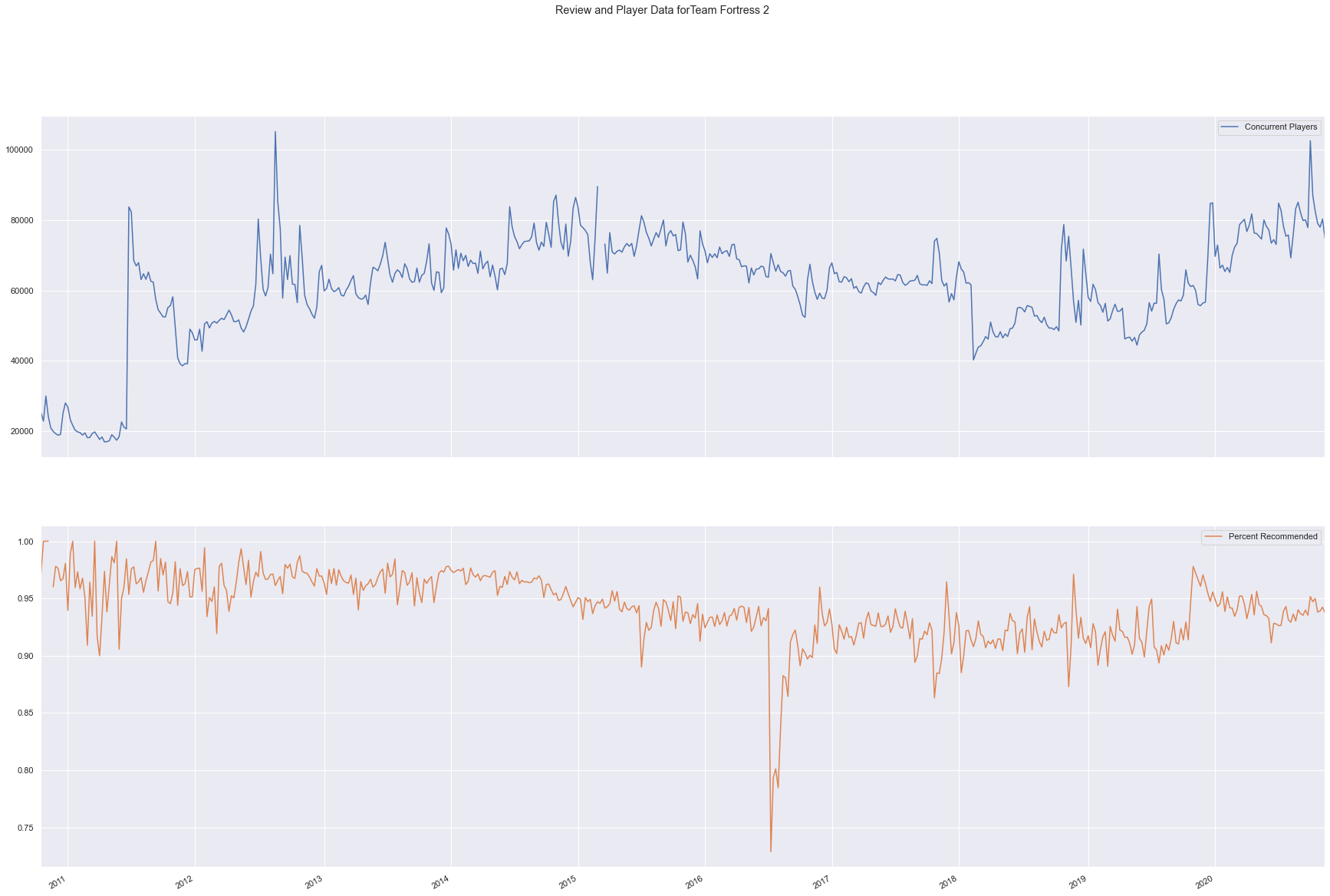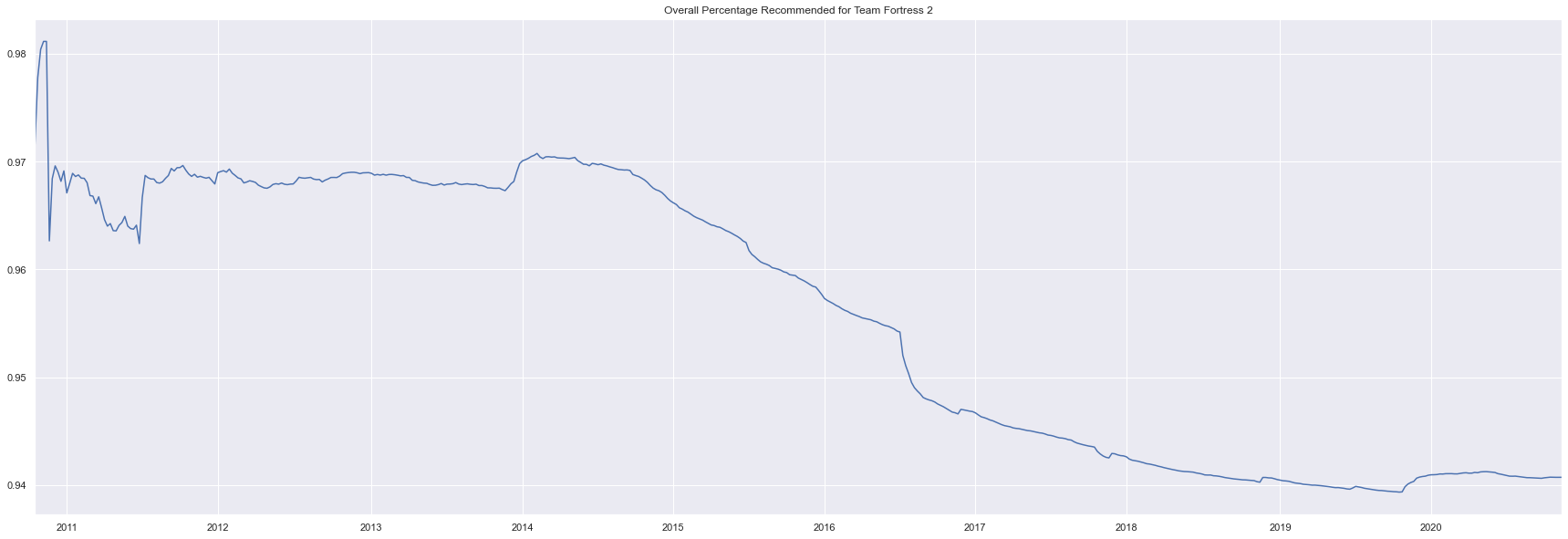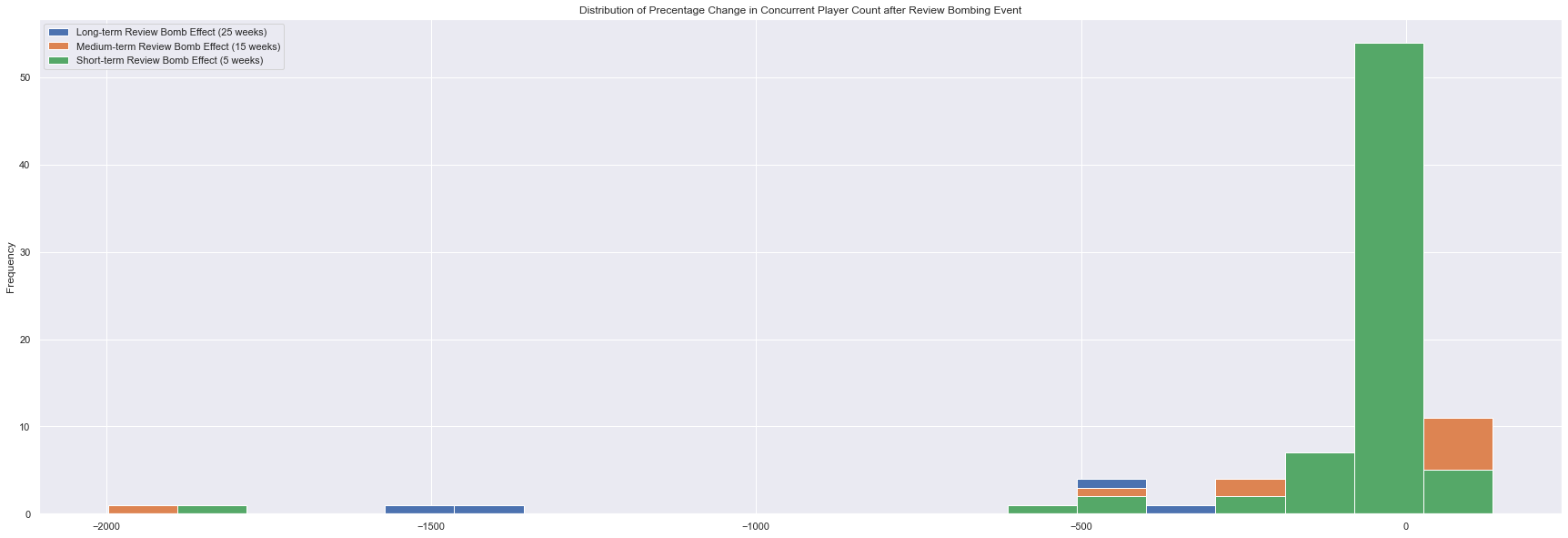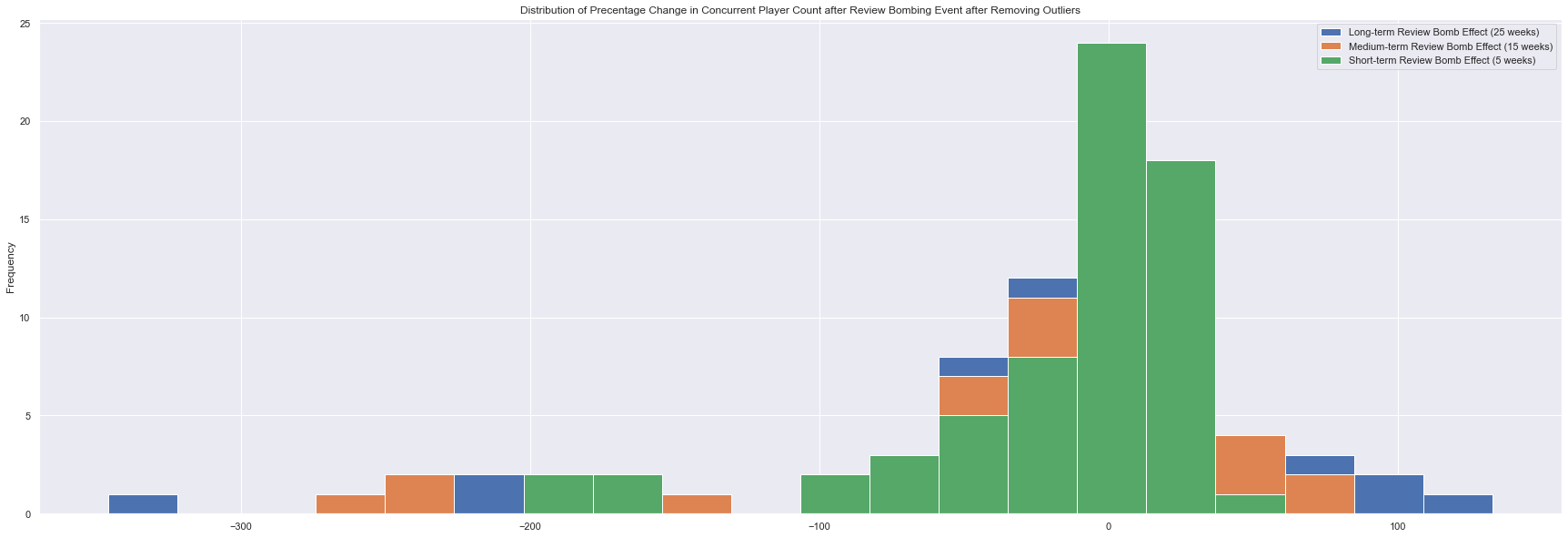Introduction
Review Bombing is a phenomenon where a large influx of negative reviews are given to a product after negative public relations events. Review bombing occurs most often in the video game industry and are characterized by reviews which do not focus on the game proper, but secondary aspects such as price, DRM (copyright-protection), a developer’s other games, or public relations statements. A demonstrative example being a mass influx of negative reviews to Doom Eternal after the creators of the game updated the game to include new DRM software. Previous case studies of specific review bombing events have shown little impact on sales, however, since many games reply on micro-transactions and in-game stores to generate revenue, it may be more important to ask if review bombing events affect the number of players actively playing a game. Perhaps review bombing is a manner of voicing concern moreso than dissatisfaction. This is what the present study investigates.
Using data from Steam itself and SteamDB, I gather time series data on 200 popular steam games. Using ARIMA models to predict future sales before review bombing events, I investigate if there is evidence of a decrease in average weekly concurrent players after review bombing events in the short, medium, and long term. I find that there is strong evidence of a short-term effect, but weaker evidence for a medium and long term effect.
Sampling Reasoning
The main reason I only consider very popular Steam games is because most Steam games are not continuously played, many fail to maintain a strong concurrent player count three months after launch. Because of this, many games can be said to have a “review bombing event” due to a small influx of negative reviews in a week because there are so few reviews being made. Having a large player-base prevents such things.
Data Collection Process
Reviews were gathered using woctezuma’s steamreviews package to mass download .json files containing review data. Data for concurrent player counts was obtained from SteamDB, for which I had to obtain special permission from the site owner to scrape their website. As such, SteamDB have asked me not to share instructions on how to scrape data from their website. Given this, and the fact that the steamreviews package is rather self-explanatory from it’s documentation, I opt not to include my raw data gathering code. Data collection took some 3 day.
Errors in Data Collection
The steamreviews package doesn’t always work perfectly, it can fail to retrieve an acceptable number of reviews (Usually only some 10% of all reviews). I am not entirely sure how to fix this, but in the end some games had to be discarded due to me facing repeated issues related to this. After filtering games that exhibit this error and games that have not been review bombed, about 70 games remained in my data set.
I created a Game object class to streamline data processing, the code for the class is below:
import datetime as dt
import matplotlib.pyplot as plt
import json
import pandas as pd
import numpy as np
import seaborn as sns
size=(30,10)
sns.set_theme()
# I realized too late that it's Concurrent, not Co-current, oops
def make_steamchart_df(appid):
# yeah this variable probably shouldn't be called df, but whatever
df = json.load(open('steamcharts/{0}_players.json'.format(appid),'r'))
start = dt.datetime.fromtimestamp(df['data']['start'])
d = {start: int(df['data']['values'][0])}
step = dt.timedelta(seconds=df['data']['step'])
for i in range(1,len(df['data']['values'])):
# go one step
start += step
if df['data']['values'][i] is not None:
d[start] = int(df['data']['values'][i])
else:
d[start] = np.nan
return pd.DataFrame(d,index=['Co-current Players']).T
def make_review_df(appid,use_ijson=False):
def make_review_dict(appid):
def timestamp_to_dt(ts):
return dt.datetime.fromtimestamp(ts)
j = json.load(open('reviews/review_{0}.json'.format(appid),'r'))
d = {}
# timestamp in tuple's first slot, recommened in second
review_ids = list(j['reviews'].keys())
review_ids.reverse() # earilest reviews should appear first
for review_id in review_ids:
d[review_id] = (timestamp_to_dt(j['reviews'][review_id]['timestamp_created']),
int(j['reviews'][review_id]['voted_up']))
return d
df = pd.DataFrame(make_review_dict(appid),index=['Review Timestamp','Recommended?']).T
# booleans will appear as objects, convert to int
df['Recommended?'] = df['Recommended?'].astype(str).astype(int)
num_reviewed = []
for i in range(len(df)):
num_reviewed.append(1)
df['# of Reviews'] = num_reviewed
df = df.set_index('Review Timestamp')
return df
def make_full_df(appid,resample_format='W-MON'):
aggfuns = {'Recommended?': np.sum,'# of Reviews': np.sum,
'Co-current Players': np.mean}
df = pd.concat([make_review_df(appid),make_steamchart_df(appid)],
axis=0,join='outer').resample(resample_format).agg(aggfuns)
# only get rows after reviews are recorded
for i in range(len(df)):
if df.iloc[i,0] > 0:
first_nz = i
break
df = df.iloc[first_nz:,:]
df['Percent Recommended'] = df['Recommended?']/df['# of Reviews']
return df
class Game():
games = []
def __init__(self, appid):
self.appid = appid #int
self.name = id_to_game_dict[appid] #str
self.data = make_full_df(appid) #DataFrame
self.__class__.games.append(self)
def has_review_bomb(self,stds_away=2):
series = self.data['Percent Recommended']
threshold = series.mean()-series.std()*stds_away
for value in series:
if value < threshold:
return True
return False
def get_review_bomb_index(self,stds_away=2):
if not self.has_review_bomb(stds_away=stds_away):
return None
else:
series = self.data['Percent Recommended']
threshold = series.mean()-series.std()*stds_away
for value, n in zip(series,range(len(series))):
if value < threshold:
yield n
def plot_autocorr(self,col):
pd.plotting.autocorrelation_plot(self.data[col])
plt.show()
I have already created Game objects for the top 200 Steam games, they can be loaded from the obj folder
import pickle
import os
game_objects = []
spellcheck = {'Co-current Players': 'Concurrent Players'}
for appid in os.listdir('obj/'):
exec('{0} = pickle.load(open(\'obj/{0}\',\'rb\'))'.format(appid))
exec('{0}.data = {0}.data.rename(mapper=spellcheck,axis=1)'.format(appid))
exec('game_objects.append({0})'.format(appid))
We can see a review bomb event for Team Fortress 2 in mid-2016 in the following chart corresponding to the release of the controversial “Meet Your Match Update,” in which many community-requested features went ignored by the development team.
game440.data.loc[:,['Concurrent Players',
'Percent Recommended']].plot(figsize=(30,20),
subplots=True,
title='Review and Player Data for'+game440.name)
plt.show()

We can also see this in the cumlative precentage of the game
def show_cum_recommended(game,plot=True,retur=True):
cum_recommended = game.data['Recommended?'].cumsum()/game.data['# of Reviews'].cumsum()
if plot:
cum_recommended.plot(title='Overall Percentage Recommended for '+game.name,figsize=size)
plt.show()
if retur:
return cum_recommended
show_cum_recommended(game440,retur=False)

Mining Games with Review Bomb Events
In order to filter games that do not have review bomb events, I look for games which have a point in their weekly review score which is 3 standard deviations lower than the mean weekly review score. The following code automatically filters games that don’t have review bomb events.
def last_nan(series,look=4): #finds last time "look"-many nan values appear in a row in a series
l = list(np.isnan(list(series))) #converts array to booleans showing if value is nan
l.reverse()
i = 0
for n in range(len(l)):
try:
if all([l[n+m] for m in range(look)]): # if they are all nan
i += 1
return i
i += 1
except IndexError:
i += 1
return None
def diff_list(l): # differences between list indexes
if len(l) < 2:
return None
diffs = []
for i in range(len(l)-1):
diffs.append(l[i+1]-l[i])
return diffs
def get_review_bomb_index(series,stds_away=3):
threshold = series.mean()-series.std()*stds_away
for value, n in zip(series,range(len(series))):
if value < threshold:
yield n
def find_review_bomb_start(game,look=4):
series = game.data['Concurrent Players']
valid_passed = last_nan(series,look=4)
if valid_passed is not None:
series = series[valid_passed:].fillna(series.mean())
reviews = game.data['Percent Recommended'][valid_passed:]
indexes = list(get_review_bomb_index(reviews))
# ARIMA models require at least 50 observations to be valid
if indexes is None or len(series) < 50 or len(indexes) == 0:
return None
starts = indexes
for n in range(len(indexes)):
try:
# 50 obs
if indexes[n] < 50:
starts.remove(indexes[n])
# is the next entry one more than the current entry?
if indexes[n] + 1 == indexes[n+1]:
starts.remove(indexes[n+1])
except IndexError:
pass
# append final numeric index to list to help with spliting
starts.append(len(game.data)-1)
if len(starts) > 1:
diff = diff_list(starts)
# merge bomb events until there are at least 50 obs between the events
while any([delta < 50 for delta in diff]):
for i in range(len(diff)):
# remove one at a time
if diff[i] < 50:
starts.remove(starts[i+1])
break
# recalculate differences
diff = diff_list(starts)
if diff is None:
return starts
return starts
else:
return None
bombed_games = [game for game in game_objects if find_review_bomb_start(game,look=2) is not None]
len(bombed_games)
81
Statistical Testing
ARIMA Models
Autoregressive Integrated Moving Average (ARIMA) models are a class of statistical models that can be used to forecast time series data. In layman’s terms, ARIMA models state that time-labeled data can be represented by adding a certain percentage of the previous data points and a random value. Specifically, the second observation of time-labeled data can be expressed as the first observation plus some white noise. Every observation after that is then a combination of the last many values and the white noise component of the last
many values.
In technical terms ARIMA models model time series data as a sequence of random variables . Let
and so on. All ARIMA models can be expressed in the form
where
for some .
The “integrated” factor refers to differencing between time steps. This sometimes must be done to maintain model validity, as ARIMA models require a constant (technically, “stationary”) mean. Luckily, such cases are still expressible in this general form, one need only shift
by some factor of
.
is explicitly given as the multiplicity of the unit root of the polynomial
.
ARIMA models can be generated via the AutoARIMA function in the pmdarima package which will fit the best-possible ARIMA model to the data based on log-likelihood. The package can then make predictions based on the expected value of the ARIMA model, , trained on data from the pre-review-bomb period to generate a time series estimation of later concurrent player counts where the review bomb did not occur. The mean percentage error between this predicted time series and the true time series will serve as the metric to judge the strength of review bombing events. Mean percentage error is used to account for differences in popularity among the games in the data set.
# declearing methods to generate ARIMA models
from pmdarima.arima import AutoARIMA
from math import sqrt, floor
def split_players_on_bomb(game):
#split the players time series into series before and after the review bomb effect
starts = find_review_bomb_start(game)
ts = game.data['Concurrent Players']
if len(starts) == 0 or starts is None:
assert 'Cannot find valid review bomb event for {0} (appid: {1})'.format(game.name,game.appid)
else:
if len(starts) == 1:
s = starts[0]
yield ts[:s-1]
yield ts[s+1:]
else:
for s in starts:
i = starts.index(s)
if i == 0:
yield ts[:s-1]
yield ts[s+1:starts[i+1]-1]
elif i != len(starts) - 1:
yield ts[s+1:starts[i+1]-1]
else:
if s != len(game.data) - 1:
yield ts[s+1:]
def est_bomb_effect(game,term=0):
# term is the number of weeks the estimator should look ahead with
l_of_ts = list(split_players_on_bomb(game))
if len(l_of_ts) == 2:
before = l_of_ts[0]
after = l_of_ts[1]
if term == 0:
term = len(after)
model = AutoARIMA()
try:
prediction = model.fit_predict(before.fillna(before.mean()),n_periods=term)
error = (after[:term] - prediction)/after[:term] # signed percentage error
yield error
except ValueError: #sometimes returns empty series
pass
else:
mean_errors = []
for i in range(len(l_of_ts)-1):
before = l_of_ts[i]
after = l_of_ts[i+1]
if term == 0:
term = len(after)
try:
model = AutoARIMA()
prediction = model.fit_predict(before.fillna(before.mean()),n_periods=term)
error = (after[:term] - prediction)/after[:term]
yield error
except ValueError:
pass
def plot_review_bomb_eff(game,term=0):
title = 'Percentage change in Concurrent players for '
if term == 0:
title += game.name
else:
title += game.name+' {0} weeks after review bomb event'.format(term)
mes = list(est_bomb_effect(game,term=term))
for me in list(mes):
me.plot(figsize=size,title=title)
plt.show()
def get_review_bomb_eff(game,term=0):
mean_signed_errors = []
mes = list(est_bomb_effect(game,term=term))
for me in list(mes):
if len(me) > 0: #fail-safe
mean_signed_errors.append(me.mean())
return np.mean(mean_signed_errors)
ARIMA estimation is quite computationally expensive, so I opt to use multi-trending
import warnings
import threading
from math import ceil
mean_signed_errors_main = {}
class RB_eff_getter(threading.Thread):
def __init__(self,threadID,name,begin,stop,ls):
threading.Thread.__init__(self)
self.threadID = threadID
self.name = name
self.begin = begin # what index to start at
self.stop = stop # What index to stop at
self.ls = ls # iterable to parse
def run(self):
for game in self.ls[self.begin:self.stop]:
global mean_signed_errors_main
mean_signed_errors_main[game.appid] = (get_review_bomb_eff(game,term=25),get_review_bomb_eff(game,term=15),get_review_bomb_eff(game,term=5))
print('.',end='')
warnings.filterwarnings("ignore")
threadLock = threading.Lock()
threads = []
print('Getting Review Bomb Effects')
split_by_threads = 10
for i in range(0,ceil(len(bombed_games)/split_by_threads)):
try:
exec('REEG{1} = RB_eff_getter({1},\'Thread {1}\',{0}*{2},(({1})*{2})-1,bombed_games)'.format(i,i+1,split_by_threads))
exec('REEG{0}.start()'.format(i+1))
exec('threads.append(REEG{0})'.format(i+1))
except IndexError:
REEGfinal = RB_eff_getter(i+1,'Thread {0}'.format(i+1),i*split_by_threads,len(bombed_games)-1,bombed_games)
REEGfinal.start()
threads.append(REEGfinal)
for t in threads:
t.join()
print()
print('Done!')
Getting Review Bomb Effects
.........................................................................
Done!
# making dict to translate appids
import csv
id_to_game_dict = {}
games = csv.reader(open('top1000steam.csv','r',encoding='utf-8'))
i = 0
for row in games:
id_to_game_dict[int(row[2])] = row[0]
# for some reason reading wouldn't work with this game in the file so I added it manually
id_to_game_dict[35700] = 'Trine Enchanted Edition'
#inverse dictionary
game_to_id_dict = {}
for k, v in id_to_game_dict.items():
game_to_id_dict[v] = k
# making error df
short_term = 'Short-term Review Bomb Effect (5 weeks)'
mid_term = 'Medium-term Review Bomb Effect (15 weeks)'
long_term = 'Long-term Review Bomb Effect (25 weeks)'
review_bomb_eff_df = pd.DataFrame(mean_signed_errors_main,index=[long_term,mid_term,short_term]).T*100
review_bomb_eff_df['Game Name'] = [id_to_game_dict[i] for i in review_bomb_eff_df.index]
We may now generate descriptive statistics for the review bomb effect of each term length
review_bomb_eff_df.dropna().describe()
| Long-term Review Bomb Effect (25 weeks) | Medium-term Review Bomb Effect (15 weeks) | Short-term Review Bomb Effect (5 weeks) | |
|---|---|---|---|
| count | 72.000000 | 72.000000 | 72.000000 |
| mean | -83.005382 | -69.180567 | -66.781793 |
| std | 268.913492 | 257.057211 | 234.835334 |
| min | -1552.735071 | -1996.633948 | -1797.020743 |
| 25% | -50.482062 | -38.689960 | -44.340836 |
| 50% | -8.992907 | -6.763253 | -0.515513 |
| 75% | 16.295495 | 16.048220 | 13.507898 |
| max | 132.797478 | 82.478413 | 47.763262 |
It seems that there are games with very major losses from review bombing events, I check this via histogram.
review_bomb_eff_df.dropna().plot.hist(figsize=size,bins=20,title='Distribution of Precentage Change in Concurrent Player Count after Review Bombing Event')
plt.show()

Given the existence of extreme values from the histogram, I opt to remove outliers from my data set.
from scipy.stats import zscore
def remove_outliers(df,rounds=2):
i = 0
clean = df.dropna()
# clean the data in rounds, outliers may hide the existence of even more outliers
while i < rounds:
# calculate Z score for all data points
Z = np.abs(zscore(clean.loc[:,[long_term,mid_term,short_term]]))
# get indexes of outliers
to_remove = np.where(Z > 3)
to_remove_labels = [clean.index[i] for i in list(set(to_remove[0]))]
clean = clean.drop(to_remove_labels)
i += 1
return clean
review_bomb_eff_df_clean = remove_outliers(review_bomb_eff_df)
review_bomb_eff_df_clean.describe()
| Long-term Review Bomb Effect (25 weeks) | Medium-term Review Bomb Effect (15 weeks) | Short-term Review Bomb Effect (5 weeks) | |
|---|---|---|---|
| count | 65.000000 | 65.000000 | 65.000000 |
| mean | -16.899673 | -16.096100 | -15.423576 |
| std | 77.150167 | 65.616488 | 51.989141 |
| min | -345.827089 | -259.424691 | -199.869738 |
| 25% | -34.079372 | -24.870464 | -25.808589 |
| 50% | -5.618843 | -5.398261 | 0.949599 |
| 75% | 16.873663 | 17.590508 | 14.506469 |
| max | 132.797478 | 82.478413 | 47.763262 |
review_bomb_eff_df_clean.plot.hist(figsize=size,bins=20,title='Distribution of Precentage Change in Concurrent Player Count after Review Bombing Event after Removing Outliers')
plt.show()

As we can see, there is strong evidence from the histogram and descriptive statistics that review bombing does have a negative impact on player bases in the short term. The medium and long term effects are a bit more difficult to see, so I opt to use a -test on the mean of each the term periods
from statsmodels.stats.weightstats import ztest
for term in [short_term,mid_term,long_term]:
resultZ = ztest(review_bomb_eff_df_clean[term].dropna(),
alternative='smaller')
print('Result of Z test against H0: μ ≥ 0 for',term.split()[0]+':')
print('Z =',round(resultZ[0],3),'(p = {0})'.format(round(resultZ[1],3)))
Result of Z test against H0: μ ≥ 0 for Short-term:
Z = -2.392 (p = 0.008)
Result of Z test against H0: μ ≥ 0 for Medium-term:
Z = -1.978 (p = 0.024)
Result of Z test against H0: μ ≥ 0 for Long-term:
Z = -1.766 (p = 0.039)
As we can see, the -values are significantly negative at a significance level of
, in fact, the short-term effect is found to be negative even at a significance level of
. This essentially means if we were to assume that review bombing does not have a negative impact on the player base of games, we would have less than a 5% chance to get the data we collected. Thus, this assumption is likely false.
One may question how often player loss from review-bombing events is prolonged in the short term. To this extent, I display the correlation matrix of my data.
review_bomb_eff_df_clean.corr()
| Long-term Review Bomb Effect (25 weeks) | Medium-term Review Bomb Effect (15 weeks) | Short-term Review Bomb Effect (5 weeks) | |
|---|---|---|---|
| Long-term Review Bomb Effect (25 weeks) | 1.000000 | 0.898958 | 0.649668 |
| Medium-term Review Bomb Effect (15 weeks) | 0.898958 | 1.000000 | 0.779988 |
| Short-term Review Bomb Effect (5 weeks) | 0.649668 | 0.779988 | 1.000000 |
As we can see, while short-term loss often translates to medium-term lost and medium-term lost is quite indicative of long-term loss, the relationship between short and long term player loss is less significant, meaning we shouldn’t always except review bombing to cause long term damage to a game’s player base.
Conclusion
- There is significant evidence that review bombing has a short-term negative effect on a game’s player base.
- There is much less significant evidence for a long or medium term negative effect.
- Most losses from review bombing are not catastrophic.
- Short-term losses do translate into long-term losses a slight majority of the time, but not always.
Research Suggestions
It may be interesting to see if the same relationship can be seen in sales rather than player count. Sadly, information about sales of Steam games is only kept by internal analytics departments or the payed website SteamSpy. If one were to take on this research, I would recommend trying to isolate the effects of price drops, which would require much more econometric analysis than I have done in this report.